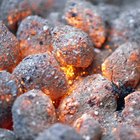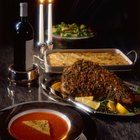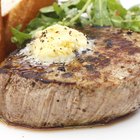
Lechon, a Filipino tradition, is a whole pig roasted on a spit over a fire. While lechon is similar to other styles of roasting pigs, the bright red skin color and stuffing ingredients distinguish this Filipino preparation method from other styles. You can feed a large crowd with a suckling pig that weighs 100 pounds or less, but you're likely to attract a few more guests as the aroma of roasting pig flows through your neighborhood. Ask your butcher, a local farmer or meat supplier for help finding a whole pig.
Step 1
Start a fire with wood in the roasting pit, using hardwoods such as oak that burn hot over a long time. You can add common smoking woods for flavor, such as apple or pecan. Chop plenty of wood beforehand so you can add it as the fire dies down. If you can't borrow or rent a rotisserie barbecue pit, scrape away grass to bare soil and stack cinder blocks to make a pit. Face the cinder block holes toward the center of the pit.
Step 2
Push a steel pipe or bamboo pole through the pig's mouth and out the back side, cracking the hip bone if needed to work the pole through the exit hole. Gather the front legs and back legs in pairs; tie them around the pole with non-galvanized metal wire.
Step 3
Season the inside of the pig with your choice of spices and seasonings. Seasonings vary across the Filipino culture, with some preferring only to rub the cavity with salt and pepper. Other options include filling the cavity with onions, whole garlic heads and lemongrass, or a combination of onions, taro and bananas. Sew the cavity closed with the same wire used to tie the feet to the pole. This requires a large needle to puncture the skin. You might have success with a large sewing needle, or make your own needle from a steel spike with a hole drilled in one end for threading the needle.
Step 4
Brush soy sauce generously on the skin, covering the hog from head to tail and back to hooves. Soy sauce is the Filipino trick to achieving red, rather than brown, skin when cooked. In addition to applying it before roasting, you can baste the hog with more soy sauce as it cooks.
Step 5
Set the pig in place over the fire pit. Slip the ends of the pole in the cinder block holes, or lock them into place in a barbecue pit that might have arms or slots to hold the pole. Turn the hog so the back faces up and lock the pole in place. If you built a cinder block pit, the pole will want to turn so the back faces down. Chock the pole against the side of the cinder block hole with a rock or brick.
Step 6
Rotate the hog once every 20 to 30 minutes to cook it evenly. This isn't necessary with barbecue pits that have an electrical spit that rotates continuously.
Step 7
Roast the pig for at least four hours or until it reaches an internal temperature of at least 145 degrees Fahrenheit. Insert a meat thermometer in the center of the meat to check the temperature. You must check several parts of the pig -- the hams, the shoulders, the loin -- to ensure it all reaches the optimum temperature. Exact cooking times vary greatly depending on the size of the pig and the heat from the fire. A meat thermometer is the best way to determine whether it is done, but look for signs such as crisp, red skin to tell if it's close to done.
Step 8
Remove the pole and pig from the roasting pit and set it on a table. Spread newspaper or butcher's paper to protect the table top. Let the pig rest for about 15 minutes before cutting into the meat. You can carve the meat yourself, if desired, but in Filipino tradition, guests usually help themselves to whichever part of the pig they prefer.
Related Articles

How to Cook a Brisket in the Ground

How to Cook Ribs Over an Open Pit

How to Do a Filipino Pig Roast

How to BBQ a Half Pig

How to Smoke a Leg of Lamb Using an ...

How to Cook Wild Boar Ribs

Roasting a Pig on a Gas Barbecue

How to Make Homemade Propane Pig Cookers
How do I Cook a Prime Rib on an Open ...

How to Cook Chicken in a Crockpot & ...

How to Cook Pork Ribs on a Propane Grill

How to Grill Pork Tenderloins on a ...

How to Cook Saba Fish

How to Cook a Bottom Round Roast on a ...

How to Cook a Cow's Head

How to Build a Hop Harvesting Machine

How to Make Collard Greens With Smoked ...

How to Cook Pork Underground

How to Cook Turkey Legs on the Grill
How to Barbecue Prime Rib Bones
References
- Serious Eats: Lechon Liempo (Filipino-style Roasted Pork Belly
- The Chicago Tribune: Roast Pig Provides Filipinos in Chicago With a Taste of Home
- USDA Food Safety Inspection Service: Fresh Pork from Farm to Table
- Amazing Ribs: Goin' Whole Hog: What You Need To Know To Roast A Hog Or Suckling Pig
- Time Magazine: Pork Art: Best Pig -- The Philippines
Tips
- Unless you purchase a live hog to butcher yourself, the hair should already be removed and the inside organs removed and cleaned. If this isn't the case, you'll need to purchase special scrapers to remove the hair while keeping the skin intact. This requires scalding the pig in near-boiling water and scraping the skin furiously before it cools down. You must also slit the hog up its belly, remove the organs and intestines, and spray it clean with a hose.
- Depending on the length of the pole and size of the pit, you might be able to fit two hogs on the same spit.
Warnings
- Contact your homeowner's association or local government office to see if open pit grilling is permissible in your area. Some areas might allow it, but require you to provide a garden hose to put out the fire if needed.
Writer Bio
A former cake decorator and competitive horticulturist, Amelia Allonsy is most at home in the kitchen or with her hands in the dirt. She received her Bachelor's degree from West Virginia University. Her work has been published in the San Francisco Chronicle and on other websites.
Photo Credits
Hemera Technologies/Photos.com/Getty Images